Week 3 Module 1: Neurons and Glial cells
1/57
There's no tags or description
Looks like no tags are added yet.
Name | Mastery | Learn | Test | Matching | Spaced |
|---|
No study sessions yet.
58 Terms
What is the average number of cerebral cortical neurons?
100 billion
Up to what speed can signals in the brain travel?
268 MPH
What is the size range of most cells?
0.01-0.05 mm
What are the two types of the cells in the nervous system?
Neurons
Glial cells
What are neurons?
Cells that sense change and communicate to other neurons
What are the basic functions of a neuron?
Reception, transmission, and transfer of information
What are glial cells?
Cells that insulate, support, and nourish neighboring neurons
How are neurons categorized?
Sensory
Motor
Interneuron
What is a sensory neuron?
A neuron that detects changes in the external or internal environment and sends information about these changes to the CNS
What is a motor neuron?
A neuron located within the CNS that controls the contraction of muscle or the secretion of glands
What is a interneuron?
Communicates only to other neurons and provides connections between sensory and motor neurons
What is the soma?
The cell body that contains the nucleus- it is the metabolic center of the neuron and contains chromosomes and DNA
What is a dendrite?
Structures attached to the soma of a neuron and receives information from the terminal bouton of an adjacent neuron
What is the myelin sheath?
A protective sheath that is made out of fat and protein; it insulates the axon and prevents the spreading of messages between axons, it also increases the speed of transmission
What is the node of ranvier?
The naked portion of a myelinated axon between adjacent oligodendroglia or Schwann cells, these allow action potentials to quickly jump from node to node
What is a synapse?
A junction between terminal bouton of an axon and the membrane of another neuron, neurotransmitters act as chemical signals and are passed between neurons in the synapse
What is an axon?
A long, thin, cylindrical structure that conveys information from the soma of a neuron to its terminal bouton
When is an axon considered myelinated?
When the myelin sheath completely wraps around the axon (usually several times)
When is an axon considered non-myelinated?
When the axon is not or is partially covered by myelin
What is a terminal bouton?
The bud at the end of an axon, it forms synapses with another neuron and sends information to that neuron
What is a neurotransmitter?
A chemical released by a terminal bouton, it can be excitatory or inhibitory when effecting another neuron
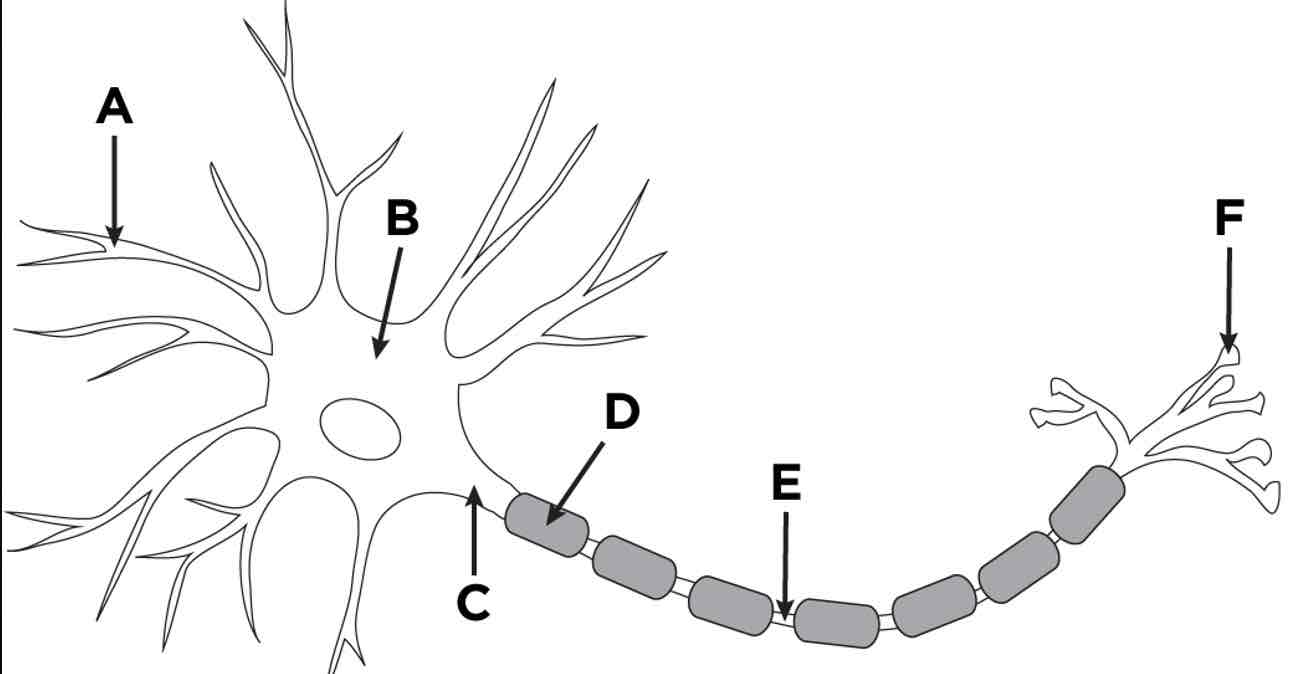
What is indicated by A?
Dendrite
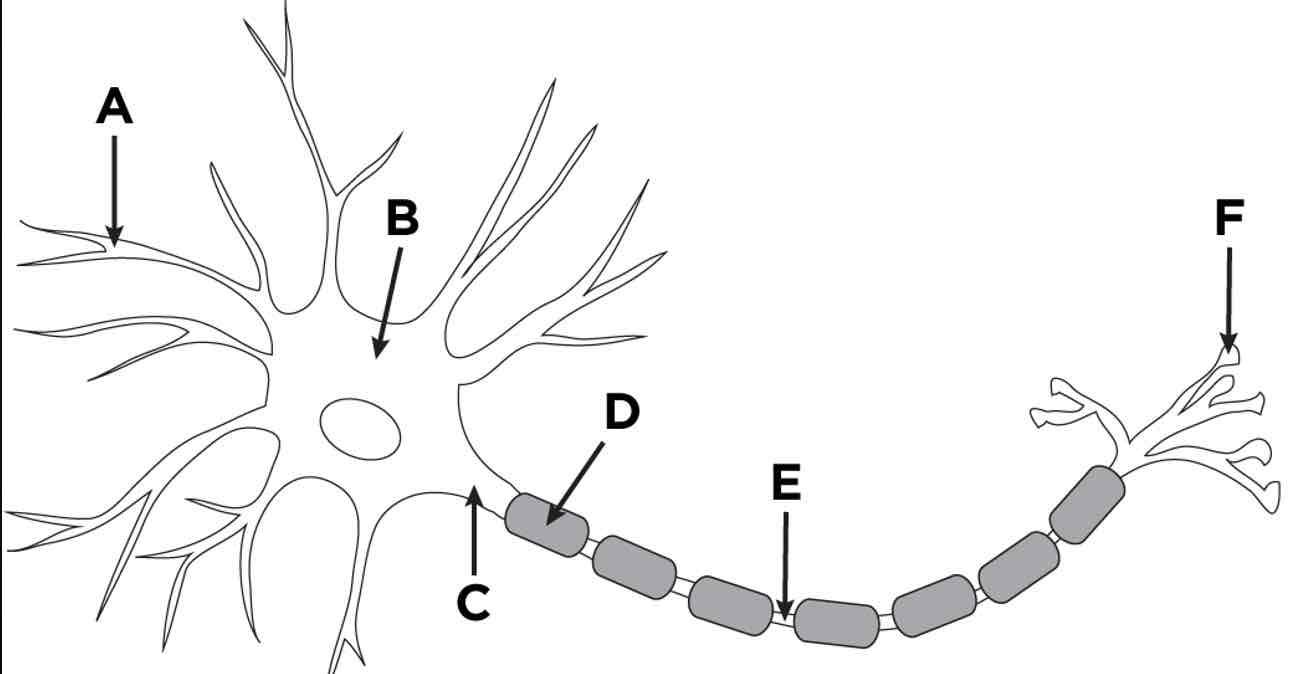
What is indicated by B?
Soma/cell body
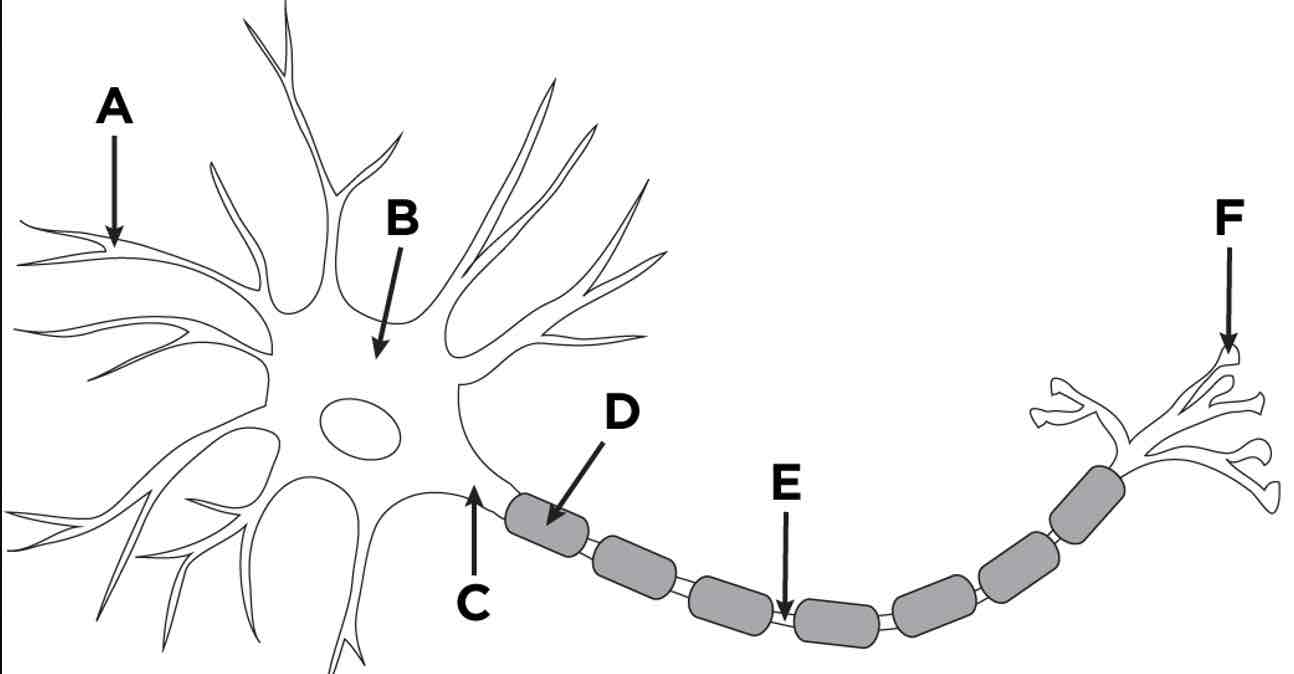
What is indicated by C?
Axon hillock
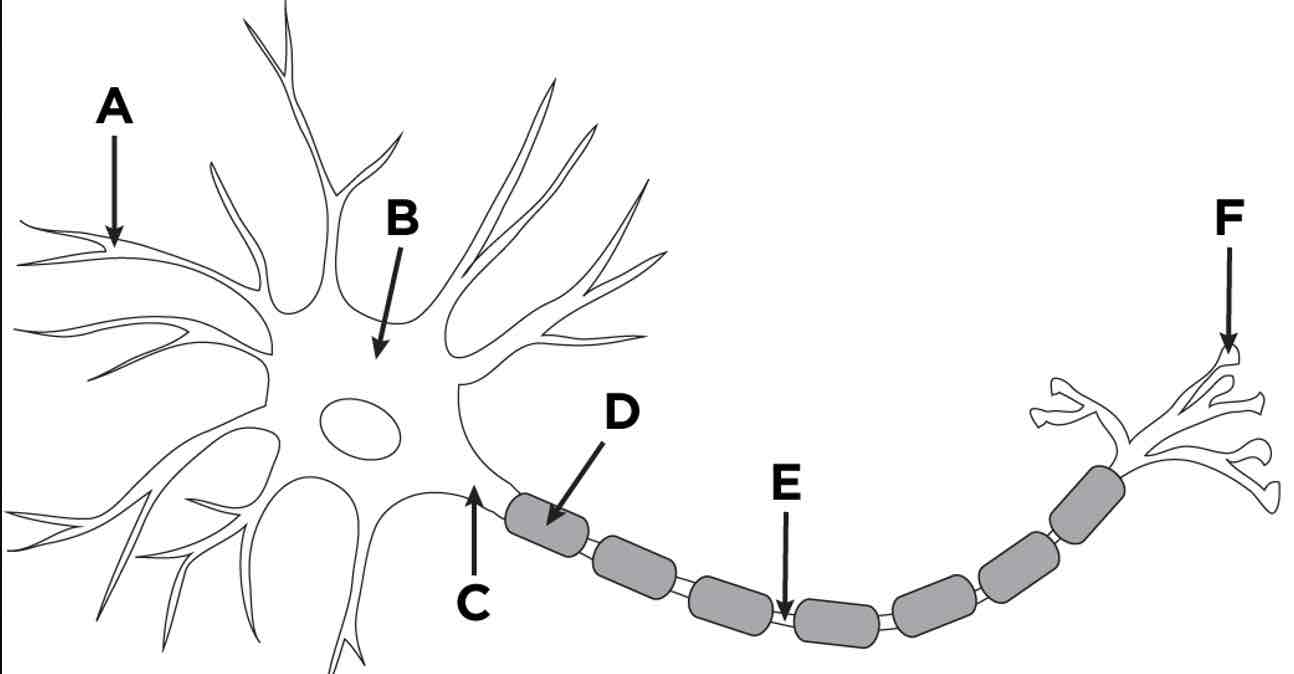
What is indicated by D?
Myelin sheath
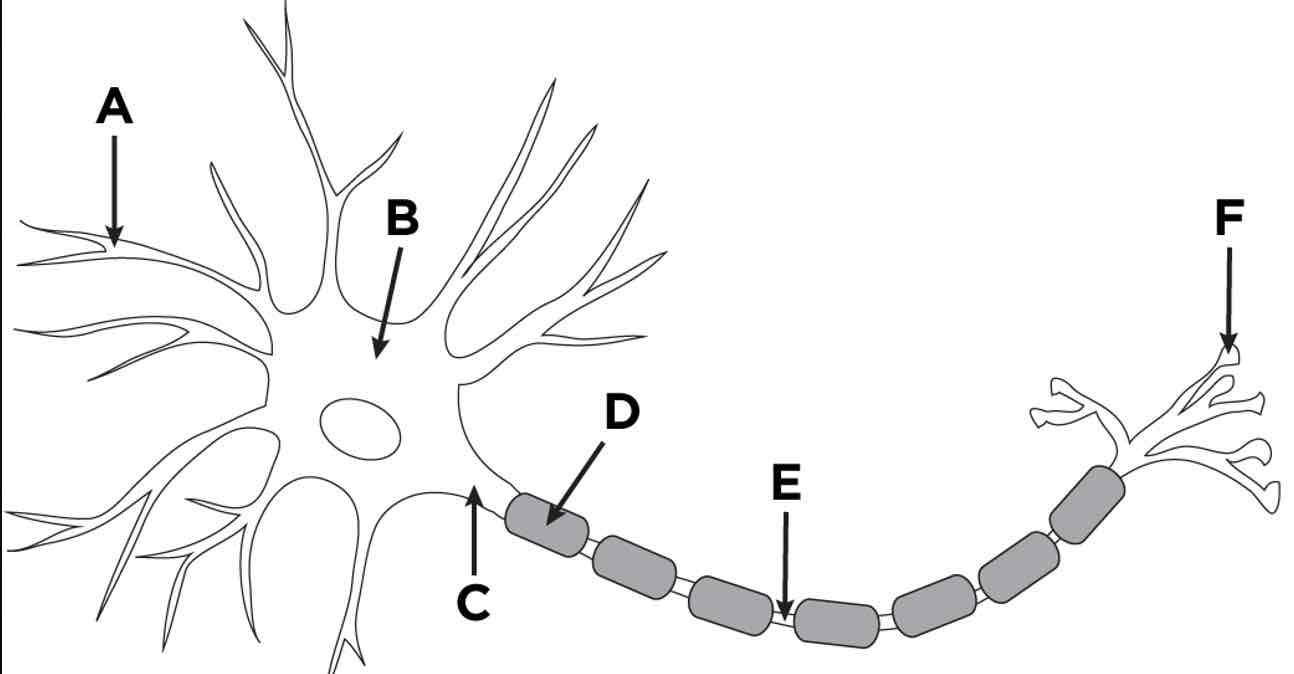
What is indicated by E?
Node of ranvier

What is indicated by F?
Terminal bouton
What is housed in the cell membrane?
I on channels that allow ions in and out of the cell
What happens when the ion channels are open?
Ions such as Na+, K+, Cl-, and Ca2+ can enter the cell
Once ions begin crossing the cell membrane through the ion channel, what happens?
Depolarization occurs, rapidly changing the electrical charge of the inside of the cell, as the electrical potential between the positive outside of the cell and negative inside of the cell causes a transfer in ions
How do neurons communicate?
By undergoing rapid changes in electrical potential across the cell membrane
What is resting potential?
The resting state of a neuron when it is not transmitting information, the inside of the neuron contains more negative charge than the outside
What is the typical resting potential of a neuron?
-70 mV
What does it mean when the membrane depolarized?
The potential becomes less negative than the resting potential (through depolarization) resulting in excitatory reaction that increases the likelihood that the neuron will generate a transmittable electrical signal
What happens when the membrane is hyperpolarized?
The potential becomes more negative than the resting potential (hypopolarization), inhibiting and decreasing the ability of the neuron to generate an electrical signal
What is action potential?
An positive ions enter through ion channels the charge inside of the cell changes to a positive charge, this triggers a signal to travel down the nerve’s axon
The response of an action potential is…
All-or-nothing, if the electrical change does not reach a certain amount the action potential will not be triggered
Ion channels are specific and open for…
Specific ions ex: a Na+ ion channel will only let Na+ through even though other ions are present
What is the threshold value that must be met or passed for the action potential to be triggered?
-55 mV
What is the hyperpolarization that occurs after the action potential is triggered?
To correct the large change in charges the cell will begin the hyperpolarization process to return the cell’s interior to its resting state, it works too well resulting in a more negative charge on the inside of the cell than its normal resting state
What are the stages or steps of the triggering of the action potential? (For example a sodium ion channel and potassium ion channel)
The cell is in its negative resting stat until a Na+ ion channel opens and lets in the positive ions which results in the inside of the cell becoming more positive
The K+ ions within the cell are pushed out through their respective K+ ion channels
The Na+ ion channel letting in positive Na ions becomes refractory and prevents more Na+ ions from entering the cell
K+ ions continue to leave the cell through their respective ion channel to slowly return the cell to its resting state
The K+ ion channel that was allowing K+ ions to leave the cell close and the Na+ ion channel resets
The extra K+ outside the cell diffuses away
What is the sequence of events following the stimulation of a sensory receptor?
A receptor potential is generated by mechanical change (pressure) of the end-receptor
An action potential propagates along the axon of the sensory neuron from the periphery to the spinal cord
Release of chemical transmitters at the synapse with the second neuron generates a synaptic potential in the second neuron
Of sufficient stimuli are received by the second neuron, an action potential is generated in this neuron
The action potential propagates along the axon
When the action potential reaches the axon terminal, a chemical transmitters is released from the terminal
The transmitter then binds to receptors on the membrane of the third neuron, and opening of membrane channels generates synaptic potentials
What are the steps involved in information being sent across synapse?
Action potential arrives at axon terminal
Voltage-gated CA2+ channels open
Ca2+ enters the presynaptic neuron
Ca2+ signals to neurotransmitter vesicles
Vesicles move to the membrane and dock
Neurotransmitters released via exocytosis
Neurotransmitters bind to receptors
Signal initiated in postsynaptic cell
What is exocytosis?
The membrane of the neurotransmitter is removed so that its contents can be released
What leads to the change in graded potential?
Once the neurotransmitter binds to its receptors
What are the 6 vital functions of glial cells?
Direct neurons
Produce myelin
Remove debris
Gather neurotransmitters
Provide nourishment
Form the blood brain barrier
What do astrocytes do?
Provides support for neurons of the central nervous system
Provides nutrients and other substances (neurotransmitter, growth factors, etc.)
Regulates chemical composition of extra cellular fluid (ion concentrations)
Blood flow in the brain (vasodilation/constriction)
What are the two main subtypes of glial cells?
Microglia
Macroglia
What are microglia?
The smallest glial cells that protect the brain from invading microorganisms
What are phagocytes (phagocytosis)?
The process of cells engulfing and digesting other cells or debris caused by cellular degeneration
When are microglia activated?
During nervous system development and following injury, infection, and/or disease
In conditions such as Alzheimer’s, Parkinson’s, MS, and ALS the microglia…
Become overly active and leads to neural damage
What are Macroglia?
The larger support neurons such as astrocytes, oligodendrocytes, and Schwann cells
How do microglia cells help during nervous system development?
Many neurons that do not make strong synapses die, and as neural cells die the microglia are lured to them due to the secretion of protein, the microglia the clean up and remove the dying cells
What are oligodendrocytes?
Cells that form myelin sheaths in the CNS
How much myelin sheaths are made from oligodendrocytes?
15-30 sheaths per cell
What are Schwann cells?
Cells that form myelin sheaths in the PNS
How much myelin is made by Schwann cells?
1 sheath per cell as the Schwann cell itself wraps around the axon